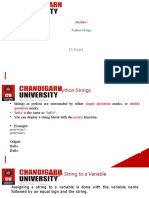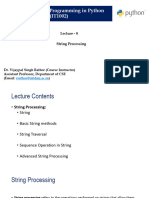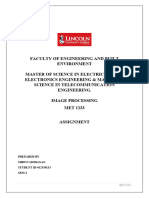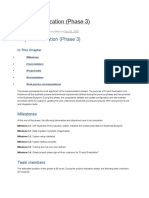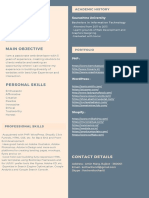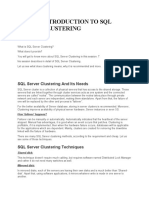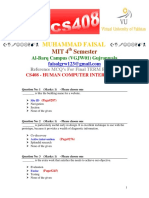1
String Operators
>> Definition:
>> String operators are special symbols used to perform operations on
strings such as joining, repeating, and checking for membership.
>> Operator Description Example
>> + Concatenation (join two strings) "Hello" + "World" →
"HelloWorld"
>> * Repetition (repeat string) "Hi" * 3 → "HiHiHi"
>> in Check if substring exists "H" in "Hello" → True
>> not in Check if substring does not exist "z" not in "Hello" → True
a = "Hello"
b = "World"
>> Concatenation
print(a + " " + b) >> Hello World
>> Repetition
print(a * 3) >> HelloHelloHello
>> Membership
print("H" in a) >> True
print("z" not in a) >> True
>> String Modification/ Methods
>> Definition:
2
>> Modification methods create a new string with changes (original
string remains unchanged because strings are immutable).
>> These methods include changing case, capitalizing, swapping case,
and more.
txt = "python programming"
print(txt.upper()) >> PYTHON PROGRAMMING
print(txt.lower()) >> python programming
print(txt.title()) >> Python Programming
print(txt.capitalize()) >> Python programming
print(txt.swapcase()) >> PYTHON PROGRAMMING → python
programming
>> Replace & Join Strings
>> Definition:
>> replace(old, new) → Returns a new string where all occurrences of
old are replaced with new.
>> join(iterable) → Joins elements of a list/tuple into a single string,
separated by the given string.
>> Replace
txt = "I like Java"
print(txt.replace("Java", "Python"))
3
>> Join
words = ["Python", "is", "fun"]
print(" ".join(words)) >> Space-separated
print("-".join(words)) >> Hyphen-separated
>> Searching in Strings
>> Definition:
>> Python provides several methods to search for text inside a string:
>> find(substring) → Returns the index of the first occurrence, or -1 if
not found.
>> index(substring) → Same as find(), but raises an error if not found.
>> startswith(value) → Checks if the string starts with the given value.
>> endswith(value) → Checks if the string ends with the given value.
txt = "I love Python"
>> Find and index
print(txt.find("Python")) >> 7
print(txt.find("Java")) >> -1
print(txt.index("Python")) >> 7
>> print(txt.index("Java")) >> Error if uncommented
4
>> Start and end check
print(txt.startswith("I")) >> True
print(txt.endswith("Python")) >> True
>> String Validation Methods
>> Definition:
>> Validation methods check whether a string contains only certain
types of characters:
>> isalpha() → Only letters.
>> isdigit() → Only digits.
>> isalnum() → Only letters and numbers (no spaces/special chars).
>> isspace() → Only spaces.
>> islower() → All characters lowercase.
>> isupper() → All characters uppercase.
txt = "Rahul123"
print(txt.isalpha()) >> False
print(txt.isdigit()) >> False
5
print(txt.isalnum()) >> True
print("123".isdigit()) >> True
print("hello".isalpha()) >> True
print(" ".isspace()) >> True
txt = "Rahul123"
print(txt.isalpha()) >> False
print(txt.isdigit()) >> False
print(txt.isalnum()) >> True
print("123".isdigit()) >> True
print("hello".isalpha()) >> True
print(" ".isspace()) >> True
txt = "Rahul123"
print(txt.isalpha()) >> False
print(txt.isdigit()) >> False
print(txt.isalnum()) >> True
print("123".isdigit()) >> True
print("hello".isalpha()) >> True
print(" ".isspace()) >> True
txt = "Rahul123"
print(txt.isalpha()) >> False
6
print(txt.isdigit()) >> False
print(txt.isalnum()) >> True
print("123".isdigit()) >> True
print("hello".isalpha()) >> True
print(" ".isspace()) >> Truetxt = "Rahul123"
print(txt.isalpha()) >> False
print(txt.isdigit()) >> False
print(txt.isalnum()) >> True
print("123".isdigit()) >> True
print("hello".isalpha()) >> True
print(" ".isspace()) >> True
name = "Chandresh"
age = 25
print("My name is {} and I am {} years old.".format(name, age))
print("My name is {1} and I am {0} years old.".format(age, name))
>> c) % Formatting (Old Style)
>> Definition:
>> Use % placeholders inside the string (%s for string, %d for integer, %f
for float).
name = "Chandresh"
age = 25
print("My name is %s and I am %d years old." % (name, age))
>> 11. Escape Sequences
7
>> Definition:
>> Escape sequences are special character combinations that represent
actions or characters that are hard to type directly in a string.
>> They start with a backslash (\).
>> | Escape Code | Meaning | Example |
>> | ----------- | --------------- | -------------------------------------- |
>> | `\n` | New line | `"Hello\nWorld"` → prints on two lines
|
>> | `\t` | Tab space | `"Hello\tWorld"` |
>> | `\\` | Backslash | `"This is a backslash: \\"` |
>> | `\'` | Single quote | `'It\'s raining'` |
>> | `\"` | Double quote | `"He said \"Hi\""` |
>> | `\r` | Carriage return | `"Hello\rWorld"` → `Worldo` |
>> | `\b` | Backspace | `"Hello\bWorld"` → `HellWorld` |
print("Name:\tChandresh\nAge:\t25\nCity:\tDelhi")
>> print=("This is a backslash: \\")
>> This is a backslash: \
>> print=("This is a backslash: \\")
>> This is a backslash: \
a = "Hello\tWorld"
print(a)
a = "Hello\tWorld"
print(a)
8
a = "Hello\tWorld"
print(a)
type(print)
>> Double Quote (\")
>> Definition: Allows a double quote inside a double-quoted string.
>> Carriage Return (\r)
>> Definition: Moves the cursor to the beginning of the line and
overwrites existing text.
c=("Helloo\rWorld")
print(c)
>> Backspace (\b)
>> Definition: Deletes the character before it.
x=("Hello\bWorld")
print(x)





